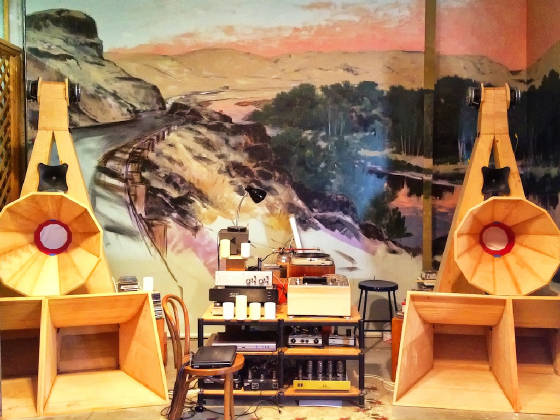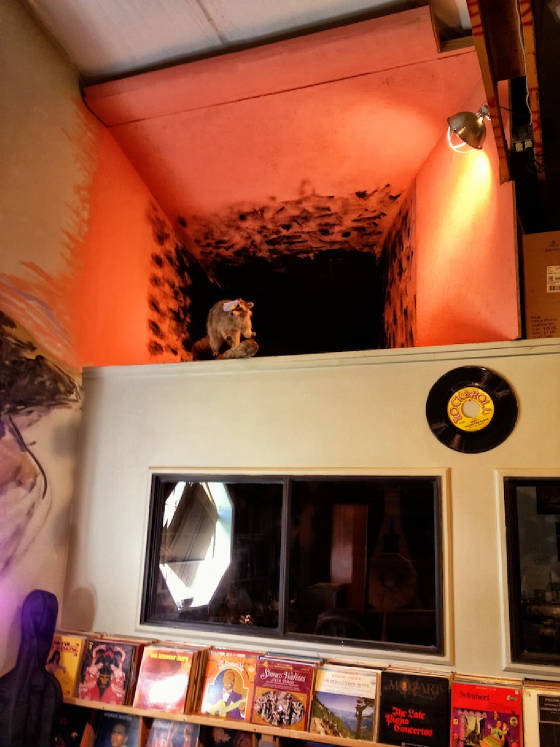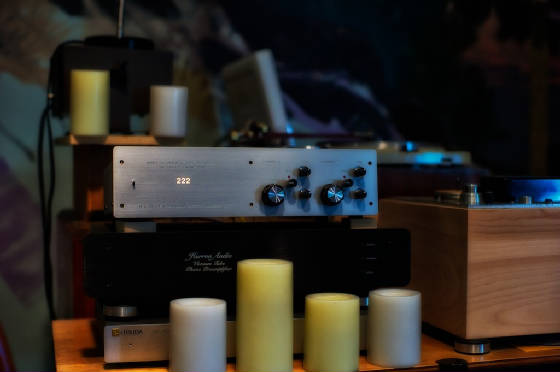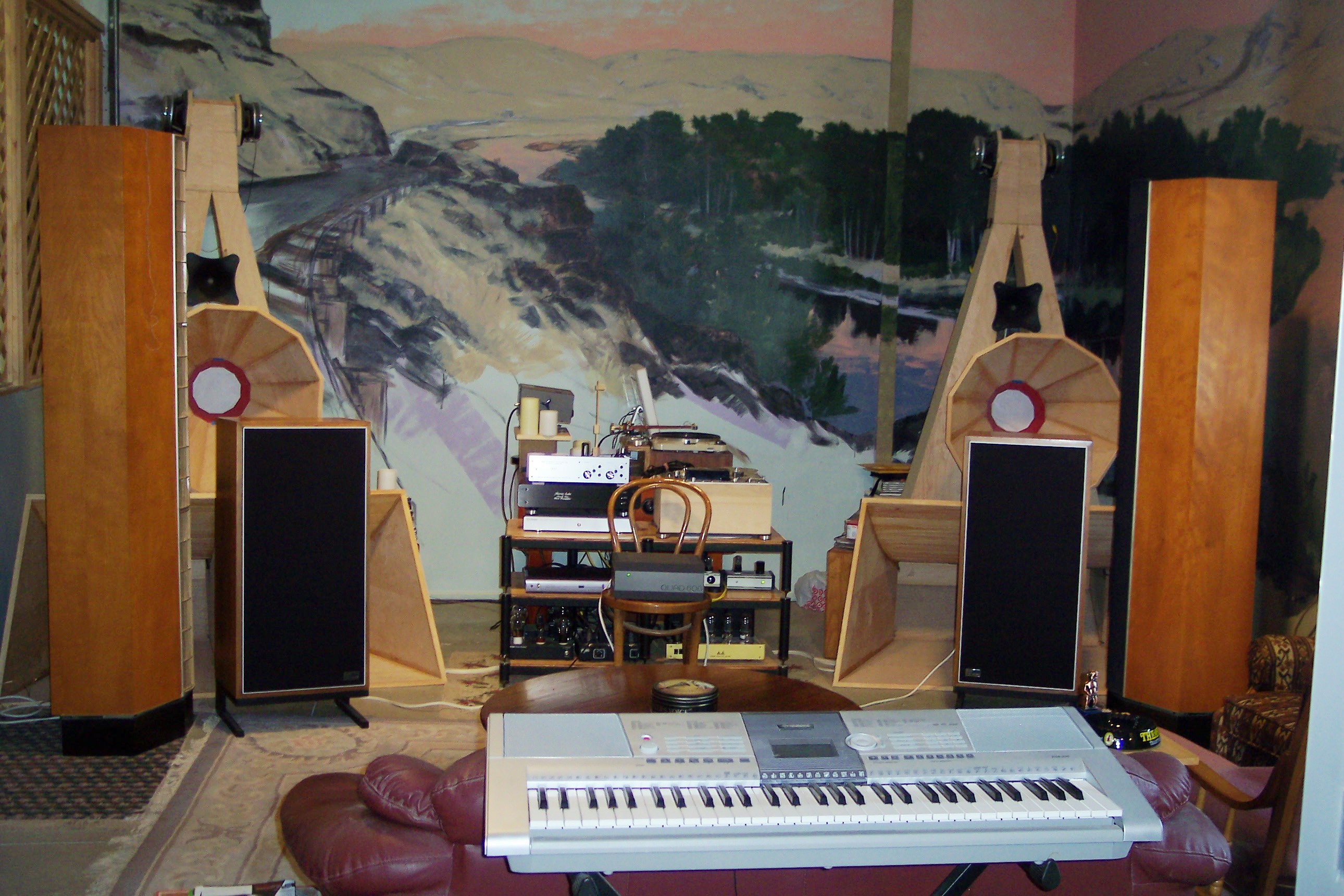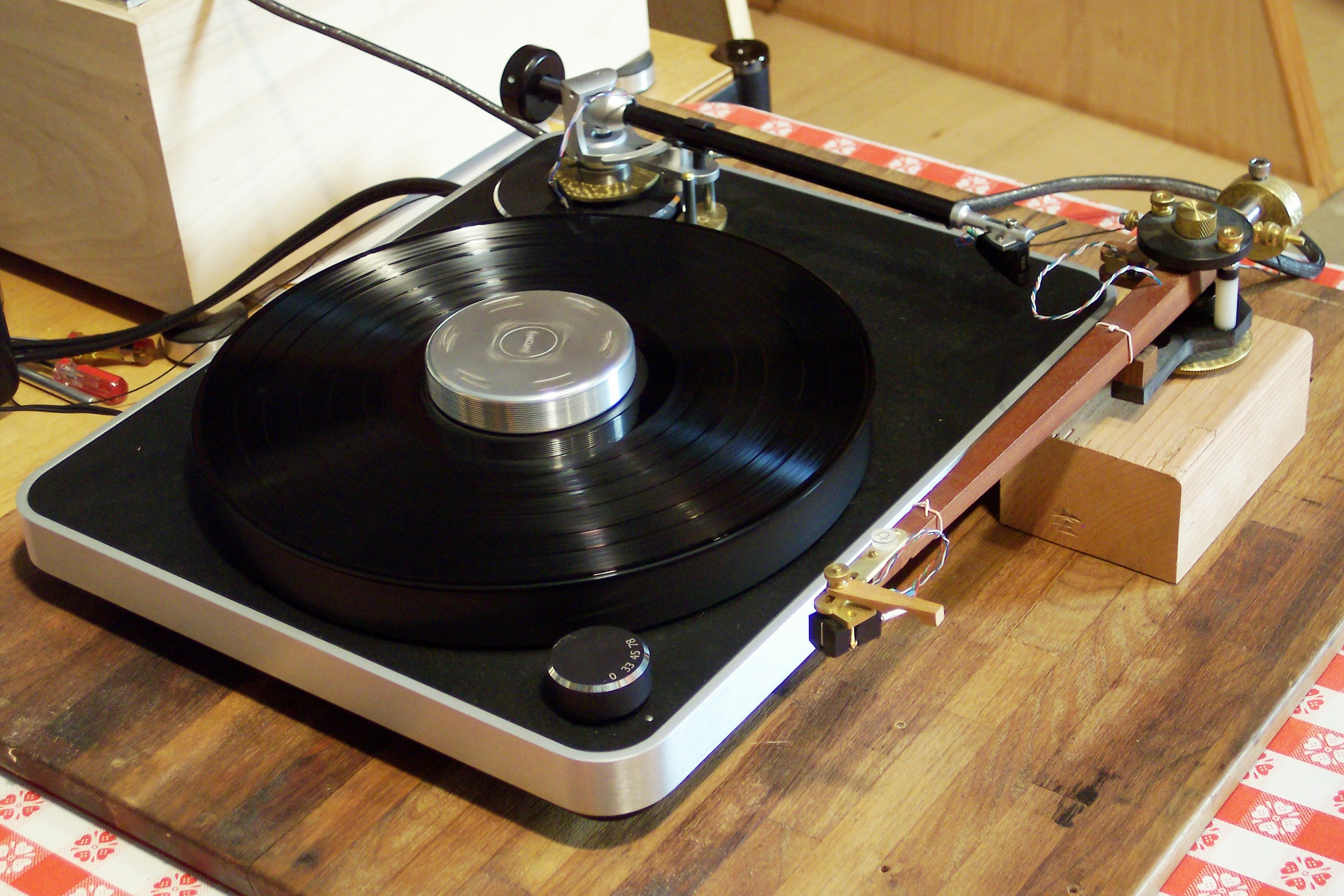|
|
"I
could never afford to purchase a Schroeder,
and The Woody is every bit as good. Every parameter you could want is easily adjustable; and it's so damn beautiful, and so musical too." - Ted Danowski An Audio Diary July 6, 2012 Listened last night to Grace Bumbry singing Carmen Jones, Heliodor HS-25046, 12" LP. Oh my goodness!!! Recommended. I'm so darned happy with the 12 inch Woody and DL103 I'm playing here in the shop. The combo of this arm and cartridge, the deHavilland Chaffee Engineering Model 222 tape-head/phono amp, and the DEQX driven horn system, has me in complete delight, wanting for nothing more. I've used a number of phono stages, including a Herron and a home improved version of the Jolida JD-9, neither of which is a slouch. The Chaffee 222 blows the other phono stages I've heard out of the water. And it has enough gain to play moving coil cartridges. This one-off prototype phono stage addition to the Model 222 Tape Head Amplifer is the only phono stage Kara has implemented. I think folks should be beating down Kara's door to get her to offer a version of the Model 222 with the phono stage. For anyone who plays tape, having the phono stage added would be a super bonus. For anyone playing vinyl, having the tape stage would be a super bonus. Kara Chaffee telephone: 360 891 6570. Kara Chaffee email: kara@tubewizard.com . July 6, 2012 Just yesterday took brass stock to my friendly local waterjet cutter to have him cut out bearing retainers which will allow the string bearing cartridge of the Woody(tm) tonearms to be user removable and replaceable. This is just one in a continuing series of subtle ongoing product improvements. The early Woody tonearms work every bit as well as the current production models, but where we can improve our methods, we do. Recently we modifed the Woody design to incorporate a brass anchor into the tail of the armwand so that we could use a machine screw to mount the counterweight assembly. This is better practice than using a wood screw in end grain, as was done in early Woody units.
July 19, 2012 Just a note here to mention that the Woody tonearm design has been modified and tested to allow the string bearing assembly (we call it the Bearing Capsule) to be replaced in the field, without sending the tonearm back to Pete Riggle. If ever a string bearing assembly requires replacement as a result of shipping damage or any other event, the owner, original or otherwise, can notify Pete Riggle, who will send a new Bearing Capsule in exchange for the old capsule. The modification to the original design is simple, and can be easily retrofitted to the original design. Contact Pete at 409 582 4548, or by email, peteriggle@msn.com, if you have questions or concerns. July 19, 2012 I've been listening a lot to vinyl, much of which is 30 to 50 years old. Some of this stuff is out of date, but still satisfying to my antique and eclectic musical taste. Some of these records I owned myself 50 years ago. Some are from collections of friends. Some are thrift shop and yard sale items. A bunch of classical organ records came from the estate of a wonderful man now known as the "Anonymous Organ Donor." A few are recent productions. What I have to report back from the front lines is that vinyl, even old vinyl, is very, very good. Out our way we live in a desert environment, which tends to be dusty. We fight the dust, but it is ever present. So it is always surprising to me when I remove a record from its jacket (there may not even be a sleeve present), dust it with airflow from my Simco Aerostat (a secret weapon available used for $15 to $75 on ebay), and drop the stylus in the groove. I don't even own a wet cleaner, but would need it on only a small percentage of the records. Part of my satisfaction is attributable to a nicely balanced audio system. The DEQX and a desirable selection of amplifiers and tubes have done wonders for the Po' Boy horns. But a lot of this is the contribution of the Woody, with a simple unadorned Denon DL103, and Kara's Chaffee's Model 222 tape stage with the phono stage added. I first became aware of the Model 222 when Kara played tape through it. I bought the 222 just for tape playback, but then got Kara to add the phono stage. The Model 222 is remarkable with both tape and phono. When I asked Kara to add phono to the EQ (a relatively small change from the tape EQ circuit) I didn't realize just how very well it would all turn out. And, good news, Kara seems to be getting serious about making the phono stage into a product. One can visualize options: 1) phono stage, 2) tape stage, 3) combined phono/tape stage.
July 21, 2012
Back around 1979 old friend Bill Van Winkle purchased a pair of IMF monitors. These are in a family of speakers developed and built in the UK and marketed in the US by Irving M Fried. These speakers use a version of the original Bailey bass transmission line, with a KEF B139 woofer and a KEF B110 midrange. Also present are a dome tweeter, I believe from Celestion, and a supertweeter from Celeston . I'll probably get this wrong, but as I understand it, Fried took a pair of developmental speakers to a consumer electronics show and walked away with about 500 orders, causing quite a bit of consternation back in the UK where the originators had no idea how to respond to this kind of acceptance. At the time I really loved these speakers, with a caveat that they did not seem to image very well, possibly due to the fact that the supertweeter was out of vertical alignment with the midrange and tweeter. Fast forward to about a year ago. Bill's IMF speakers were out in his garage gathering dust, so he handed them off to his old friend Ron Barbee, who is pretty much an unparalleled technical whiz, a constant amazement to the rest of us. Ron did some work to lower the crossover point between the woofer and midrange, and had them playing when Portland/Vancouver friends Kara Chaffee and Harry Zweben came to visit. Kara took an immediate liking to what the transmission lines do, and has since switched to transmission line bass for the monitors she uses in amplifier development. Subsequently Harry purchased a pair of IMF TLS80 II speakers offered on Craigs List. Kara and Harry outfitted these speakers with a pair of Kara's favorite tweeters, the Hiqufon OW1, and disconnected the supertweeter which was no longer needed. I then sold Harry a Quad 606 solid state power amp, which really made these speakers sing. I'm generally a tube guy, but the Quad 606 can be marvelous with the right speakers. My reaction, and that of others who heard the Frieds with the Quad in Harry's listening room, was that this combination of amp and speaker is extremely musical. Subsequently, I bought the Quad 606 and the IMF speakers from Harry. That is how incestuous audio gets with these friends. Today I'm listening to the combination of the modified IMF speakers and the Quad 606 power amp. I have to say to the world, that this is one magical combination. The tonality is marvelous, and the imaging problem mentioned earlier went away with the Hiqufon tweeter and elimination of the supertweeter. The Hiqufon OW1 is one delicious tweeter. This setup is a nice complement to the Po' Boy horns and the Beveridge Model 2SW electrostats in the Garden of Earthly Delights, providing an excellent set of direct radiators to round out the electrostats and horns. For someone who wants a top notch pair of direct radiator speakers and a robust reliable solid state amp, this combination would be hard to beat. Expect to pay about $500 for a nice used pair of IMF Monitors, about $250 for a pair of the Hiqufon OW1 tweeters, and about $650 for a Quad 606. These speakers work well in a large room, well away from the walls. In a small room they may be boomy.
July 24, 2012 Some further comments are in order regarding on the IMF TRS 80 II speakers with the Quad 606 solid state amp: It is important to emphasize that the bass on these speakers in some ways leaves something to be desired. The bass driver working with the Bailey transmission line is a KEF B139. This is the KEF "racetrack" configuration. As I understand it from others that know this driver well, the B139 can be a little mushy on certain bass passages. And this sometimes shows up, but objectionably only on certain passages. A kick drum does not elicit the desired transient response. Other drums and percussion are typically super wonderful. It seems the driver loves to do legato bass, but sometimes muffs the job on stacato bass. It is my understanding that the problem here, to the extent that there is one, lies in the KEF B139, not the transmission line. In the Garden of Earthy Delights the bass extends way low, and is robust, Rubenesque, and musical. Quite lovely on most material. I acquired a used pair of B&W No. 250 woofers that I might be able to squeeze into the transmission line cabinets, and hope to give these a try, as they have a great reputation. But my best guess is that whatever failings the B139 drivers have, we will probably lose more than we gain if we swap them out. All in all, I'm quite favorably impressed with the IMF speakers driven by the quad amp. Not quite as amazing as the Po' Boy horns, but a wonderfully musical system that may be found, used of course, for $1400 plus shipping. Once again, don't put these in a small or boomy room.
August 22, 2012: Last weekend I had an opportunity to hear Kara Chaffee's monitor audio system. Kara is the sole proprietor of de Havilland Electric Amplifer Company, and Chaffee Engineering. The system I heard is the system Kara uses to listen into what is going on in the amplifer products she develops. The system I heard had Kara's Ultraverve preamp, her 50A power amplifers, interconnects by Joe Cohen, and Kara's modification of Cambridge Audio transmission line loudspeakers. While textbooks on the subject (for example Martin Colloms' High Performance Loudspeakers) suggest that you can get the same performance from a sealed box speaker as from a transmission line (and with less volume for the sealed box), the practical experience of others, including myself, contradicts this suggestion. Kara has modified the Cambridge loudspeakers by eliminating the supertweeter, replacing the tweeters with the Hiqufon OW1 units, replacing the KEF B210 full range mid drivers with KEF B210 midrange mid drivers, and replacing the problematic KEF B139 woofers with 8 inch woofers taken from a Harbeth product. I have probably never heard more beautifully relaxed inner detail from any system. At even low volumes every nuance seemed to be graciously revealed. The credit for this goes to Kara's remarkable knowledge of amplifer design (she can make any amplifer sound better), to Kara's knowledge of the various British loudspeaker drivers (the Brits do know a lot about loudspeaker design), and to Kara's recognition that a direct radiator speaker intended for a small to moderate sized room should have transmission line bass, with a tweeter, a midrange, and a smallish woofer crossed over pretty low. Also, unlike the IMF monitors, the drivers should be arranged in a vertical line. Also, we have to give credit to the Fisher folks who developed the original 50A, and to Kara's recognition on hearing a Fisher 50A, that this amplifer topology is something special, worthy of being resurrected in the Chaffee Engineering version of the 50A. September 7, 2012
See an image below of VTAF on a Clearaudio Concept Table with the Clearaudio Verify arm and Ortofon 2M Black cartridge. I outfitted the arm and table with the VTAF. While fitting the VTAF to a separately sold Verify arm is straightforward, there is too much labor and risk in this modification of the Concept table for me to recommend it to others. The Verify arm is an interesting device, using a string and magnet bearing system something like used by Frank Schroeder in his tonearms. An interesting difference between the Schroeder design and the Verify design is that, whereas the Schroeder arm has the string above the armwand, with the magnet below, the situation is reversed in the Verify arm. In the Verify arm the magnet force carries the entire weight of the tonearm wand system, and also provides additional force to provide tension for the bearing string. As I understand it, the concept used in the Verify arm was implemented by someone in Japan in the nineteen eighties. It is interesting the Frank Schroeder obtained a patent on a configuration so obviously related to the one used by the Verify arm. There are undoubtedly nuances in how the designs are implemented. Said nuances may be relevent to Herr Schroeder's patent. I did notice with the Verify arm that there is a somewhat undamped low frequency resonance of the tonearm mass against the radial stiffness of the baearing. Comparing the behaviour of the Verify magnetic bearing with the behaviour of the Stringtheory(tm) bearing used in the Woody(tm) tonearms was interesting. I noticed that the Stringtheory bearing is substantially stiffer radially than the Verify bearing. Using the Concept table with a Woody tonearm and a Denon 103 cartridge provided a quite more musical result than using the Verify arm with the same cartridge. The Concept table, though lightly constructed, turned in a lovely performance with the Woody tonearm and the Denon DL103 cartridge. The Ortofon 2M black cartridge was brand new, lacking the benefit of break-in. It was not possible to make a fair assesment of the 2M cartridge.
September 24, 2012:
The turntable used today is the AE-2008, an Empire 208 table refurbished and enhanced with a solid 3/4" thick aluminum top plate by Mike Paschetto of Analog Engineering. Kudos to Mike. This is a wonderful sounding table. I first heard this table in Jeff Day's listening room, and thought it was excellent. Today's listening session has reinforced the earlier observation, and taken the Paschetto version of the Empire table even higher in my esteem. You may read Jeff Day's review of the Paschetto AE-2008 table at the following link: http://www.6moons.com/audioreviews/analogengineering/208.html OK. Let's cut to the chase. The Analog Engineering table and the 14 inch Woody have taken the sound in the Pete Riggle Engineering and Audio listening room (known locally as the Garden of Earthly Delights) to a new reference level. This is somewhat surprising to me, because I have been exceedingly happy lately with the musicality of the current system and room. Credit for the improvement seems to be attributable to the Analog Engineering table outperforming the resident Thorens TD124. And, in an outcome I did not expect, the 14 inch Woody seemed to my ears to have a slight performance edge relative to the 12 inch Woody, across the sonic spectrum. Perhaps this is just an overactive imagination on my part. I'll be interested in verification by my esteemed listening panel when the opportunity presents itself, and by Kendall, when he has had a chance to compare the 14" and 12" Woody arms. The opportunity to hear another 14" Woody here in the Garden of Earthly Delights may be a slow train coming, because the 14 inch Woody ships tomorrow. Both the 14 inch and the 12 inch Woody arms make utterly gorgeous music, in my opinion, and do it with the affordable Denon DL103 (check low Denon cartridge prices at comet.supply.com). And how about the Jelco arm with the VTAF and the Denon DL103? Excellent arm for the money. Not quite as transparent when compared with the 14 inch and 12 inch Woody arms. Perhaps with the right cartridge. That is the news for the day from "Out Our Way." One more image below, showing both the 14 inch and the 12 inch Woody arms mounted using the Sticky Putty Block Method. No cartridges or finger lifts in this image. The images shown here today do not do justice to the finish of the wood tonearms. And some day I will do a nice finish on that beat up old cutting board used today as an isolation platform.
November 26, 2012:
Carpentry is nearly complete on a plinth I am building for the Garrard 301. See attached image. Next I'll do one for a Bogen branded Lenco (Bogen Model B61). Finally I'll do one for the Thorens TD124 now in use in the listening room. I'll use comparable materials and construction for each of the three plinths. This will allow comparison of the tables on comparable plinths. Interestingly, a Bogen B61 table is the first non-changer table I owned (Circa 1960). I had no idea what I was discarding when I sold it. Ah, foolish youth. I like the plinth design and construction I am using. Like many others, I glued rectangular layers of 3/4 inch birch plywood (with appropriate cutiouts) and and then sawed them into a perfect rectangle on the table saw. To hide the laminations the four sides were cased using plywood from the same sheet, resawn on the table saw into two 5/16" thick layers. Recesses with a cross section 5/16 inch square were left at the four sides of the top, the four sides of the bottom, and the four corners. Into these recesses will be glued solid birch trim strips. Finally the plinth will sanded smooth with an orbtal palm sander, with grits ending up at about 3000 grit, and then French polished. To avoid the hassle of clamps slipping while glueing the layers, I added layers, one at a time, the second layer to the first, etc., with a pneumatic brad nailer, allowing an hour or so of glue setting between successive layers. Hand nailing with finish nails would work as well. I spaced the nails in a square matrix about 2 inches apart. Now that I think about it, one could use just a few nails (as few as two) and use multiple clamps and cauls. For me nailing is easier. Tonearm mounting will be with a separate rectangular block plinth for each tonearm, as discussed in an earlier entry, said tonearm block plinth secured with tacky putty at the side to the turntable plinth, and/or at the bottom to the shelf or isolation board which supports the turntable. This is a really simple system that makes it easy to adjust the tonearm or swap tonearms between tables. For mounting spikes I purchased four each 1/4 inch brass screws, removed the heads, and brought one end of each to a point using a band sander and finishing with 220 grit in the drill press. Cost of the hardware for the mounting spikes was about $10. Near the pointed end of each screw a brass nut is fixed with Locktite Red 271 thread locker, providing something to grip when adjusting the screw. These screws will be threaded into metal inserts at each corner of the plinth bottom, with another brass nut to serve as a lock nut after leveling the plinth. I prefer four feet to three. For the Garrard plinth I used 7 layers of plywood. the top two layers were cut out using the pattern recommended in the Garrard 301 Manual. The next four layers have a much smaller cutout, just enough to clear the motor assembly. The bottom layer has no openings. I will use the captive power cord that came with the Garrard. A small hole at the rear of the plinth will allow the cord to exit the plinth. It will be necessary to remove and reinstall the plug. It turns out that a plinth with a removable power cord is a bit more of a hassle than one might imagine. I'd rather remove and replace the plug, than unsolder wires from a receptacle, and deal with a length of wire inside the plinth. It will be a lot of fun to compare the Thorens TD124 with the Garrard 301 and the Lenco. I've heard the Thorens and the Garrard in recent years. The Thorens (modified to eliminate ringing of the aluminum top hat over the cast iron platen) has a very smooth, polite, and refined presentation. The Garrard has DRIVE, and knows how to boogie. It will be interesting to find out which of these tables is preferable, and to whom, and on what music.
|

